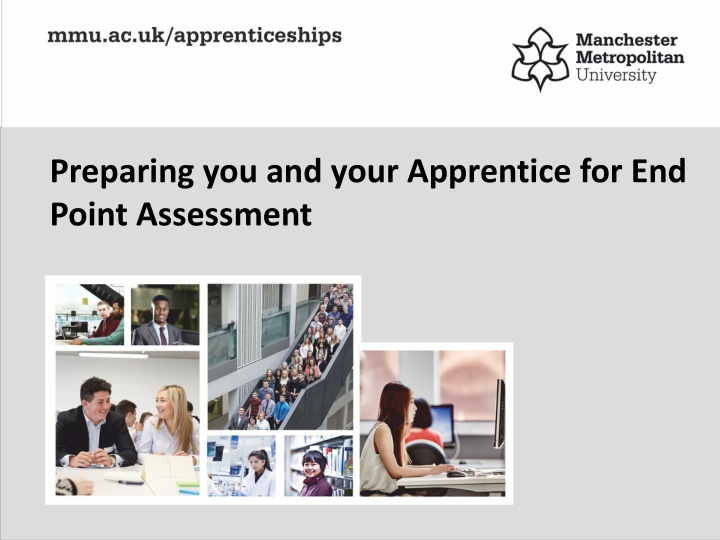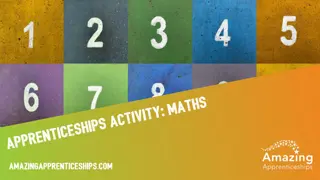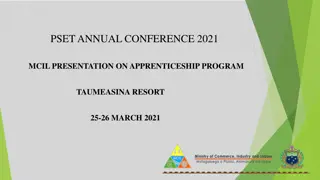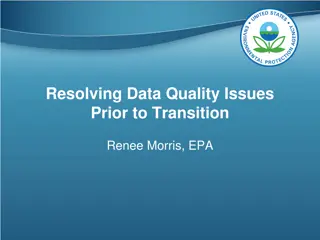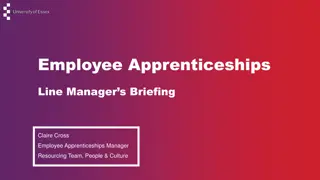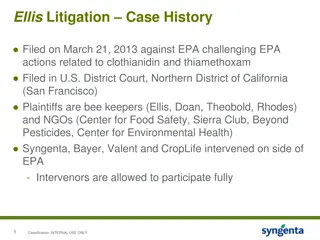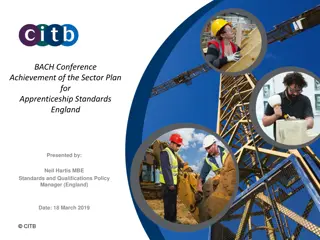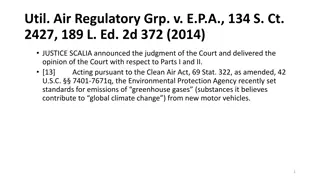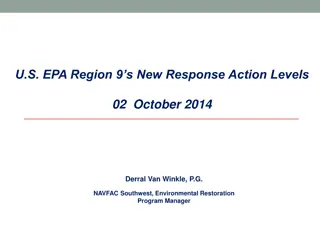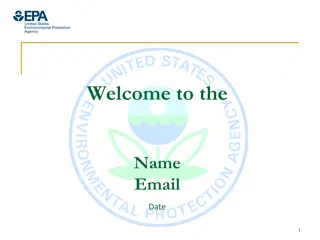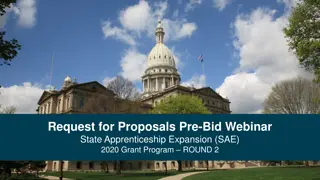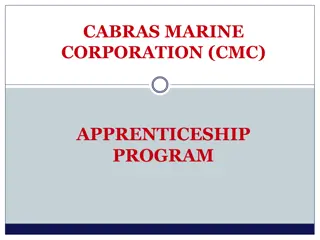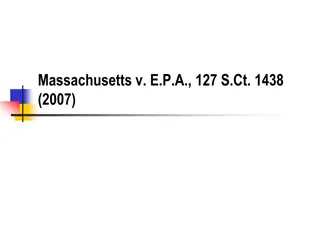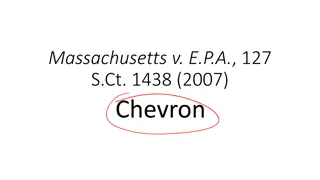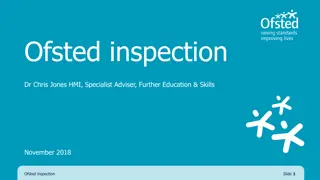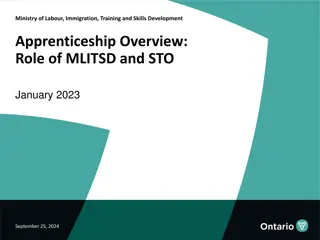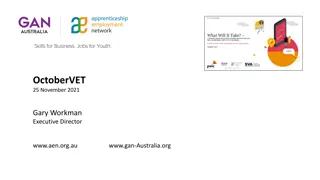Comprehensive Guide to End Point Assessment (EPA) for Apprenticeship
This detailed guide provides an overview of the End Point Assessment (EPA) process for apprenticeships, including timelines, requirements, and key steps such as project presentation, vocational competence discussion, and scenario evaluation. It covers aspects like completing the apprenticeship, Gateway requirements for Laboratory Scientists, and tasks for both apprentices and assessors. Essential elements like getting a registered assessor approved, ensuring completion of required work, and assisting with presentations are highlighted. The importance of EPA for future funding eligibility is emphasized, along with the role and responsibilities of the Registered Assessor in liaising with relevant authorities for EPA arrangements and final sign-off.
Download Presentation

Please find below an Image/Link to download the presentation.
The content on the website is provided AS IS for your information and personal use only. It may not be sold, licensed, or shared on other websites without obtaining consent from the author.If you encounter any issues during the download, it is possible that the publisher has removed the file from their server.
You are allowed to download the files provided on this website for personal or commercial use, subject to the condition that they are used lawfully. All files are the property of their respective owners.
The content on the website is provided AS IS for your information and personal use only. It may not be sold, licensed, or shared on other websites without obtaining consent from the author.
E N D
Presentation Transcript
Preparing you and your Apprentice for End Point Assessment
Agenda End Point Assessment (EPA) Timelines What's involved in EPA? Project Presentation Vocational Competence Discussion Scenario Case Study
Completing the Apprenticeship On Programme M1-M33 Gateway End Point Assessment M34- M36 FdSc vocational competence Synoptic Project (final 6 months). L2 Maths & English Employer confirms Synoptic Project Presentation & discussion Vocational competence discussion FdSc course Synoptic Project (This is EMS project) Competence Evaluation Log Scenario Case Study Behaviours Evaluation
What is The Gateway Gateway requirements for L5 Laboratory Scientist L2 English & Maths FdSc (or BSc) in Chemical Science Workplace Synoptic Project Competence Evaluation Log (CEL) Behaviour Evaluation MMU will send SIAS confirmation of your FdSc + English & Maths GCSE as soon as possible after course ends The rest has to come from apprentice and employer!
Timelines EPA -8M EPA -1M EPA -3M EPA -2M EPA! Submit project paper to SIAS Identify the registered assessor: need SIAS approval and induction SIAS agreed schedule and confirm EPA date All gateway evidence sent to SIAS Submit schedule to SIAS
What should you be doing now? Getting your registered assessor approved and inducted! Making sure apprentices have completed OneFile work Signing off competences in CEL Helping apprentices with presentation Apprentices need to have taken EPA to be eligible for funding on future apprenticeship (e.g. top-up)
The Registered Assessor Ideally work for apprentices company Must be vocationally competent Must have experience of current working practices. Must complete SIAS application and induction. (induction can be done by phone)
Registered Assessor role Liaise with SIAS to arrange EPA Final Sign off of CEL Participate in Synoptic Project Presentation; discuss and evaluate apprentice performance with SIAS Assessor. N.B. SIAS Assessor makes final decision!!
Signing off the CEL competences 21 competences (aligned to units in OneFile) All need signing by representative of employer; usually apprentices mentor. Can be done at any point but all need to be signed by Gateway.
Behaviours evaluation At gateway need to Complete this table Apprentice must meet or exceed expectations in all areas. SIAS guidance on completing this
Registered Assessor sign-off Final sign-off should be done when ALL gateway evidence complete (including FdSc). This starts 3 month countdown to EPA.
Project Presentation & Discussion Project Report Submit paper to SIAS; 4 weeks before EPA Make sure this meets SIAS criteria; need to amend MMU report to do this (e.g. include relevant word count & amend titles). This paper isn t marked but SIAS will use to confirm that project meets requirements.
Project Presentation (20-30mins) SIAS says: The presentation should focus on the practical application of the science that underpins the project and the conclusions of the work. They would also like to see how they managed the project. Slides showing project plan, risk management and/or highlighting key stakeholders would be good. This needs to be a much bigger presentation than the one they do for MMU! Opportunity to present this at work before EPA as practice?
Project Discussion (45-60mins) This will involve 4 Questions in the following areas Apprentices can prepare for these as know what they ll be asking! Their understanding of the principles of laboratory techniques relevant to the project. The apprentice should be prepared to explain how this influenced the choice of experimental design and methods. Why did you do it the way you did? Literature precedent? The analysis, interpretation and presentation of their results. The panel may explore the results, data analysis, the challenging of assumptions and drawing of conclusions. The apprentice may wish to refer to their use of software packages, relevant tools and project management techniques. The reasoning behind the recommendations and the benefit to the business. Why was this helpful? Their use of personal and professional skills to support delivery of the project plan. This means how they worked with others, communicated what they were doing, project management skills and considering impact of work on others (e.g. minimising disruption).
What is project assessed against? Data analysis, use of IT Data analysis, results interpretation Project Mgt & Scope Drawing Conclusions & Impact 9 Criteria Problem Solving Project Personal & Professional Skills Scientific principles of techniques Recommendations Presentation
Project Grading Pass: Meet pass expectation for all 9 assessment elements. Distinction: Meet distinction expectation for all assessment elements. SIAS have provided tables which show the what they are looking for in pass and distinction categories. Please make sure your apprentice looks at these!
Vocational Competence Discussion (VCD) Apprentices should think about What they personally did Use specific examples from their job IMPACT; what was the benefit to the business of what they did? (may need to explain how your business works for this to be clear). Explain context & think about the competence (e.g. developing new process) they re showing rather than technical detail There are 8 questions and VCD should take between 60- 90 mins
VCD Question areas Apprentices should go into EPA having already thought of examples which meet these criteria. THINK IMPACT!!!
Preparing for the VCD Think of good examples for each question area Think how they can explain these clearly to someone who doesn t understand their job role. Focus on what youdid; not general at my company we .. ! IMPACT! If possible quantify this. It can be helpful to think about consequences if you did things differently. They should be able to talk for 7-10mins on each Q! We ll do some mock questions at their final review The specific questions will vary BUT you know the areas they ll ask about!
VCD Grading For pass meet pass criteria for all questions For distinction meet pass criteria for four questions and meet distinction criteria for at least four questions. Think IMPACT! Again; SIAS have produced tables which show criteria for each grade.
Overview Scenario Case Study 2.5h written test (3 tasks) Aims to test ability to apply knowledge and skills to new environment Case study may include issues in areas such as H&S Compliance with procedures & regulation Ensuring good practice Organisation culture; e.g. approach to change Accuracy and validity of results
The Scenario Case Study Task 1: Write a summary outlining the issues that are identified within the narrative that may have consequences for the business, the employees or the customer. For each issue describe the consequences that may result and who may be affected. [Total: 20 marks] As a general guide there should be 20-25 issues. To get good marks they ll need to identify and evaluate most of these.
The Scenario Case Study Task 2 a. For the issues that you have summarised in task 1 evaluate the situations that you believe have led to the issues arising, you should consider factual causes stated in the narrative as well as any possible situational causes that you have inferred from the whole case study. Group issues together that have similar causes, justify your groupings and explain any assumptions that you have made. (15 Marks) b. Based on your evaluation of the whole case study and consideration of the linkages between the situations, identify the root causes that you believe the company needs to address. Justify your answer and explain any assumptions that you have made. (15 marks) You could start by listing factual and inferred causes and then grouping accordingly; e.g. H&S issues, non-compliance with regulations/procedures, validity of results etc
The Scenario Case Study Task 3: Produce a series of recommendations to help the organisation prevent these types of situations arising in the future. Explain and justify how your recommendations will address the root causes identified in task 2. Include any critical questions that the organisation needs to consider and identify any difficulties that may prevent your recommendations being accepted. [Total: 30 marks] There are no specific right and wrong answers. The importance thing is to justify and explain your answers and any assumptions.
Scenario Case Study grading Marked out of Pass Distinction 80 40 60 There is an example SCS in the material sent to you by SIAS. We used this for an activity at residential week. Please feel free to discuss further with your apprentices!
Summary Make sure you re currently Ensuring apprentices CELs are signed off Getting registered assessors inducted Arranging EPA dates with SIAS Your apprentices can prepare. Encourage them to Identify examples for VCD Practice their presentation
